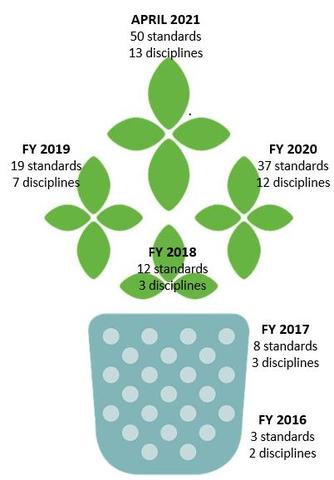OSAC and the Registry: In Full Bloom
By John Paul (JP) Jones II, OSAC Program Manager
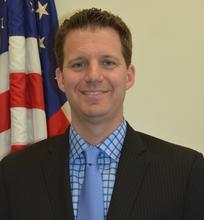
It’s May, and spring is in full bloom! Spring is a time of renewal and growth, and new life can be seen all around us. Just as seeds grow into green shoots, then into blooming flowers, the OSAC Registry has also reached a new stage of growth recently. The OSAC Registry is a repository of high-quality, technically sound published and proposed standards for forensic science. We’re excited to share that last month we added the 50th standard to it!
Administered by the National Institute of Standards and Technology (NIST) as part of the Special Programs Office’s Forensic Science Program, OSAC aims to strengthen the nation’s use of forensic science by facilitating the development of technically sound standards and guidelines and encouraging their use throughout the forensic science community. OSAC’s 450-plus members and 300-plus affiliates work in forensic laboratories and other institutions around the country and have expertise in 22 forensic science disciplines, as well as scientific research, measurement science, statistics, law, and policy. These experts volunteer their time to draft and evaluate forensic science standards to ensure they are scientifically sound. It takes a diverse group of stakeholders to nurture an idea into a standard that has both scientific rigor and considers the current operating environment faced by today’s forensic service providers!
I’ve been a part of OSAC since it was created in 2014, and I’ve experienced the growth of the organization and the Registry first-hand. As we mark this latest Registry milestone, I want to take a moment to go “back to our roots” and reflect on how much OSAC and the Registry have bloomed over these past seven years.
Planting the Seeds
In February 2009, the National Research Council (NRC) published Strengthening Forensic Science in the United States: A Path Forward. This report assessed the state of forensic science and made recommendations for strengthening the field. One of these recommendations was for the development and widespread adoption of uniform and enforceable standards and best practices in forensic science, thus planting the seeds for the creation of OSAC.
To address the NRC report, the White House Office of Science and Technology Policy (OSTP) coordinated the establishment of the Subcommittee on Forensic Science (SoFS). From July 2009 until December 2012, the SoFS formed several Interagency Working Groups (IWGs) to form recommendations to address forensic science challenges. One of these groups, the Standards, Practices, and Protocols Interagency Working Group (SPP IWG) investigated the complex issues associated with forensic science standards and the infrastructure that supported standards development. As part of their review, the SPP IWG looked at the existing 21 Scientific Working Groups (SWGs) that operated independently of each other. At that time, SWGs existed to determine best practices and develop consensus standards within a particular area of forensic science. The SPP IWG realized that if the SWGs could receive unified support and operate in a standardized structure, they might become more effective. As a result, in 2010, the SPP IWG developed the concept of the Scientific Working Group (SWG) Program Management Office (PMO) that NIST could manage.
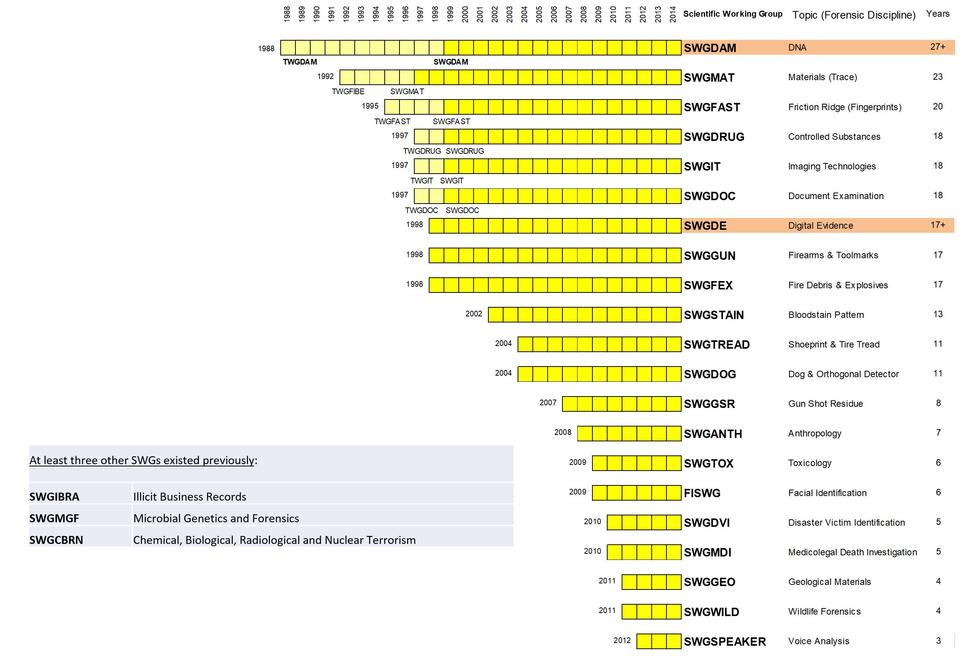
The SWG PMO idea was refined over the years based on lessons learned from connecting with the SWGs and seeing how NIST engaged in standards related topics. To strengthen and enhance the practice of forensic science, NIST and the U.S. Department of Justice announced a collaboration in February 2013 launching the National Commission on Forensic Science (NCFS) and Guidance Groups (later renamed OSAC). Under this arrangement, DOJ and NIST would serve as co-chairs for the NCFS, and NIST as the administrator for OSAC. After much research and stakeholder input, NIST announced the creation of OSAC on February 4, 2014 at the inaugural NCFS meeting.
Starting to Grow
Soon after its creation, OSAC selected its 500+ members to populate the newly formed standards infrastructure. In January 2015, these forensic scientists, researchers, legal experts, human factors experts and quality experts met in Norman, Oklahoma for the first ever OSAC subcommittee meetings. The initial goal was for the subcommittees to reflect on the state of standardization in their specific forensic science discipline and prioritize a standardization pathway forward. One year later, OSAC held its inaugural “All-Hands” Meeting on January 27, 2016 in Leesburg, Virginia. More than 500 OSAC members were in attendance with the goal of fostering the development of discipline-specific standards and also working across disciplines on broader standards. It was during this event that then NIST Director, Willie May, announced the addition of the first standard, ASTM E2329-14 Standard Practice for Identification of Seized Drugs, on the OSAC Registry.
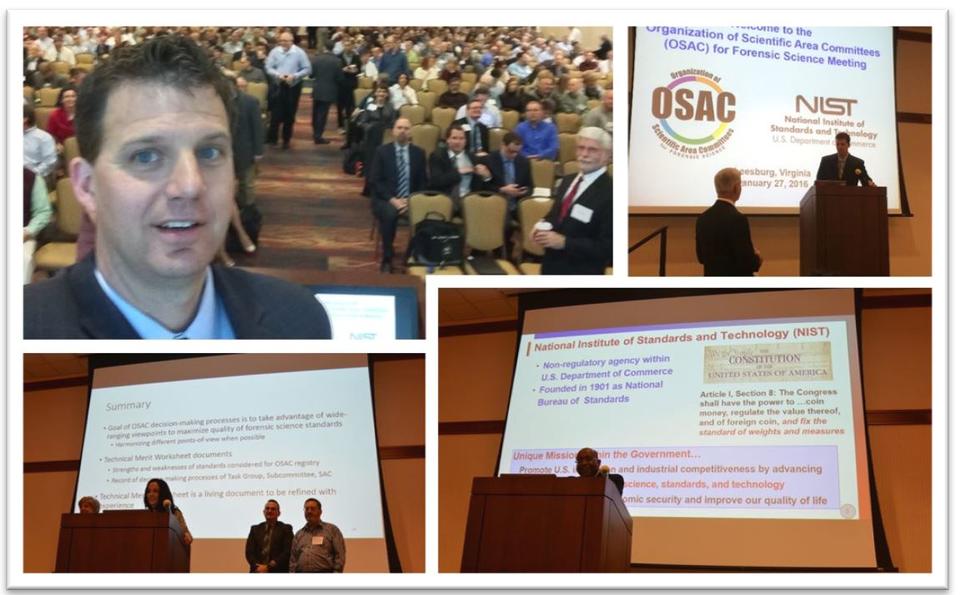
In Full Bloom
To help make high-quality, science-based standards available to the forensic science community more quickly, OSAC launched a change to its structure and processes in October 2020. For example, to help improve internal coordination and reduce duplication of efforts, OSAC combined closely related subcommittees and authorized the ability to form interdisciplinary committees to address topics that span multiple traditional forensic science disciplines, ensuring our new structure could adapt if needed to future changes.
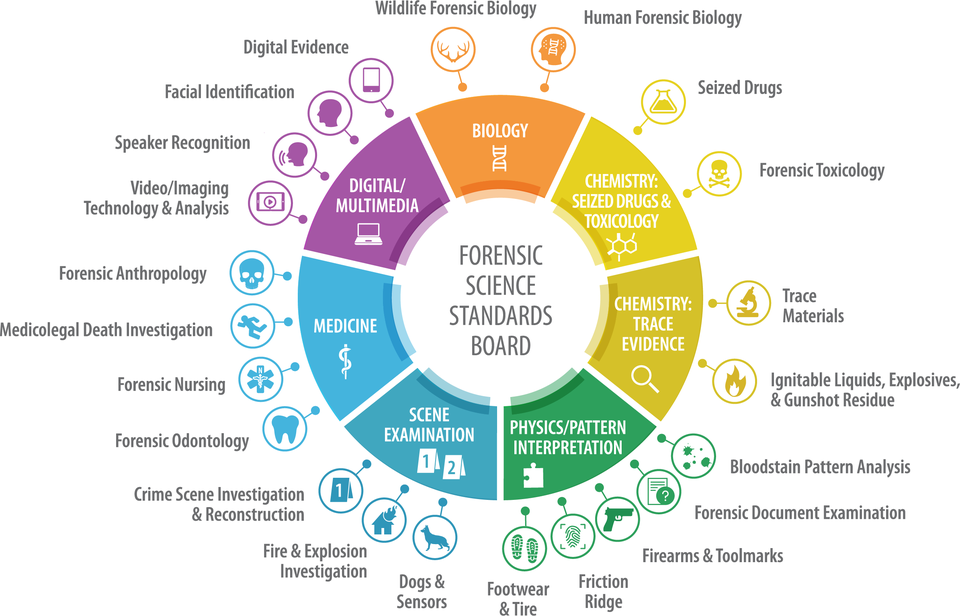
In addition, we expanded the Registry to include two types of standards. The first, published standards, are fully developed standards that have been published by a standards developing organization (SDO). The second, OSAC Proposed Standards, are new or revised standards that have been drafted by OSAC and sent to an SDO to be further developed and published. These proposed standards have undergone the same rigorous technical review as the published standards on the Registry. To help fill the standards gap during the time it takes for an SDO to complete the standards development process, OSAC encourages the forensic science community to implement these high-quality proposed standards. An OSAC Proposed Standard may be revised during the SDO development process, and once available, the SDO published standard will replace the OSAC Proposed Standard on the Registry.
On April 6, the first two OSAC Proposed Standards were added to the Registry (one for human forensic biology and one for wildlife forensic biology). Also, on this date the first firearms standard and a new fire debris standard were added to the Registry, bringing the total number of standards to 50!
OSAC is beginning to see the fruits of its labor come to realization as more organizations are starting to become aware of and encouraging implementation of the standards on the OSAC Registry. For example, all seven forensic science professional organizations represented on OSAC’s Forensic Science Standards Board, have formally declared their support of OSAC and for the development and implementation of forensic science standards. You can read their published policy and position statements here.
Staying Grounded
OSAC’s core principles of balance, consensus, harmonization, and openness are deeply rooted in the standards OSAC drafts and approves for the Registry. The continued dedication, time, and efforts of OSAC’s leaders, members, affiliates, and stakeholders to make high-quality standards available to the forensic science community are greatly appreciated. OSAC may be a federally funded program, but its success is due to the significant volunteer contributions of the 450+ volunteer members and 300+ affiliates who contribute their time freely to improve the practice of forensic science through standardization, making this a true partnership. OSAC looks forward to the continued growth of the organization and the Registry in the coming years.
